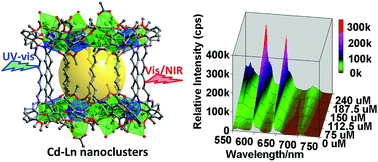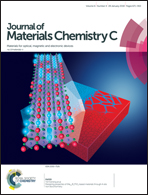Anion dependent self-assembly of drum-like 30- and 32-metal Cd–Ln nanoclusters: visible and NIR luminescent sensing of metal cations†
Abstract
Two types of drum-like 30- and 32-metal Cd–Ln nanoclusters [Ln8Cd24L12(OAc)48] (Ln = Sm (1), Yb (2), Er (3)) and [Er8Cd22L12(OAc)38(OH)6] (4) were constructed using a designed Schiff base ligand built around a flexible (CH2)7 chain. Hydroxide (OH−) anions are found in the structure of 4, indicating that the basic environment favors the formation of the 30-metal cluster. The chromogenic Cd/L components in these clusters can act as efficient sensitizers for lanthanide luminescence. With the Ln(III) centers enclosed within the drum-like structures, 1–4 display the typical emission spectra of lanthanide ions. For the Cd–Er clusters, 3 exhibits better NIR luminescence properties than 4. The long-chain Schiff base ligands show “linear” configurations in these clusters, resulting in the large sizes of 1–4. The drum-like structures of 1–4 have inner cavities with the internal sizes approximately 6 × 11 × 11 Å, and some solvent molecules such as H2O, MeOH and EtOH are enclosed in the drums. Interestingly, the Cd–Sm cluster 1 shows visible and NIR luminescent sensing of metal cations and exhibits high selectivity to Zn2+ and Fe3+ ions.



 Please wait while we load your content...
Please wait while we load your content...